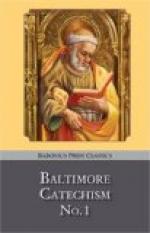Besides the Hail Mary there is another beautiful prayer on the same subject, called the Angelus. It is a little history of the Incarnation, and is said morning, noon, and evening in honor of Our Lord’s Incarnation, death, and resurrection. It is made up of three parts. The first part tells what the angel did, viz.: “The angel of the Lord declared unto Mary. And she conceived of the Holy Ghost.” After saying these words, we say one Hail Mary in honor of the angel’s message. The second part tells what Mary answered, viz.: “Behold the handmaid of the Lord. Be it done unto me according to thy word.” We say another Hail Mary in honor of Mary’s consent. The third part tells how Our Lord became Man, viz.: “And the Word was made flesh. And dwelt among us.” The “Word” means here the Second Person of the Blessed Trinity; and “made flesh” means, became man. Then another Hail Mary is said in honor of Our Lord’s goodness in humbling Himself so much for our sake. After these three parts we say: “Pray for us, O Holy Mother of God! that we may be made worthy of the promises of Christ”; and, finally, we say a prayer in honor of Our Lord’s Incarnation, Passion, and Resurrection. This beautiful prayer is said three times a day in all seminaries, convents, and religious houses. The time for saying it is made known by the ringing of a bell called the “Angelus bell.” In many parishes the church bell rings out the Angelus. In Catholic countries the people stop wherever they are and whatever they are doing, and bowing their heads, say the Angelus when they hear its bell. It is a beautiful practice and one most pleasing to our Blessed Lord and His holy Mother. Good Catholics should not neglect it.
I might mention here another kind of prayer often said in honor of our blessed Mother. It is the Litany. In this form of prayer we call Our Lady many beautiful names which we know are most dear to her, asking her after each one to pray for us. We address her first by names reminding her that she is the Mother of God and has therefore great influence with her divine Son. We say: Mother of Christ, Mother of Our Creator, Mother of Our Redeemer, etc., pray for us. Next we remind her that she is a virgin and should take pity on us who are exposed to so many temptations against holy purity. We call her virgin most pure, virgin most chaste, etc., and again ask her to pray for us. Lastly we call her all those names that could induce her to hear us. We say: health of the weak, refuge of sinners, help of Christians, pray for us.
In addition to the Litany of the Blessed Virgin, we have the Litany of the Holy Name of Jesus, the Litany of the Blessed Sacrament, the Litany of the Sacred Heart, the Litany of St. Joseph, and many others—all made up in the same form. We have also the Litany of all the Saints, in which we beg the help and prayers of the different classes of saints—the Apostles, martyrs, virgins, etc.




